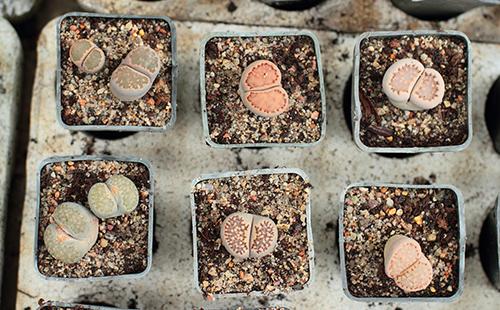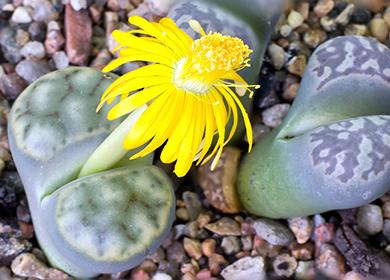The content of the article
Lithops are the smallest house plants. The maximum size of an adult specimen barely reaches 4 cm. They have one interesting feature - during a drought, live stones are buried in the ground, where they wait for a dry period.
Botanical Description
Lithops are stemless succulent plants consisting of only two leaves. They have a convex, conical, or flat body, depending on the variety. At the root, the leaves are fused. The cut between the leaves is of different depths - superficial or deep. The colors are different - light gray, beige, pink with spots and stripes.
Periodically, an independent rejuvenation of the plant occurs - a change of old leaves. The leaves begin to dry out, wrinkle, gradually decrease. From below, in their place, new fleshy young leaves make their way.
Lithops bloom in late summer. In the crevice between the leaves appears up to three buds at a time. Flowers do not fade for about ten days, can be quite large - the size of the plant itself or even larger.
Varieties
Different types of lithops differ in color, size, shape, nature of spots and stripes. In total, more than 30 plant species are known, and hybrid varieties exist. The most common are six varieties.
- Olive green. The coloring is malachite, with single whitish spots. Leaves are almost completely fused. Size - up to 2 cm. Blooms in early autumn, rather large yellow flowers.
- Optics. Leaflets strongly separated, grayish or pale green. The shape of the plant is round. There are varieties of purple. Size - about 2 cm.
- Aucamp. Larger plant, up to 4 cm in diameter. The color is green, with a dark brown stain at the top. The flowers are yellow, the same diameter as the plant.
- Leslie. An interesting tiny variety a little more than a centimeter in size. The leaves are bright green in color, at the top of the marble pattern. The flowers are medium sized, white, with a pronounced aroma.
- Marble. The leaves are grayish, a marbled pattern is clearly pronounced on the surface. Rounded, smooth shape, extended up. The flowers are white, large - up to 5 cm.
- Brownish. The plant is cylindrical in shape, with a flattened tip. The color is brownish, with darker orange or brown spots. The flowers are small, yellow.
Plant life cycle
Lithops (living stones) are not quite ordinary plants. Growing them requires knowledge and understanding of the life cycle of a flower. Care is also important: living stones do not bloom usually with improper watering. With the onset of summer, they plunge into a dormant period, coinciding in time with the dry season in the homeland of growth. During rest, the pots are practically not watered. But occasionally, you can slightly dampen the surface of the soil if the leaves began to wrinkle.
By the end of August, the plant wakes up. Rare, but plentiful waterings renew. The cleft between the leaves gradually spreads, a flower bud becomes visible. When the flowering is over, the old leaves gradually die off, in the place where the flower was, a new pair is visible.
Young leaves grow slowly - from autumn to the end of winter. During this time, the old ones completely dry out, wrinkle. At the stage of leaf ripening, the plant is practically not watered; it is kept in a cool room. Watering resumes after completion of the upgrade process.
Lithops Care: Basic Rules
How to care for lithops in order to achieve flowering and new leaves? The rules are similar to growing most succulents. But there are some minor differences. The following requirements are recommended.
- Lighting. The need for lighting is high. They love the sun, grow well on the southern windowsill. In summer, put away from the window glass to avoid burns. If it is impossible to provide full natural light in the winter, they arrange lighting. In the shadow they develop slowly, are drawn to the light, do not bloom.
- Temperature. They like moderate heat, react negatively to heat. Optimum temperature: 22-25 ° C. In the resting phase, it is reduced to 12-15 ° C.
- Watering. It is necessary to water lithops occasionally, and very moderately. The most abundant watering occurs in the spring - watered with a small amount of liquid at two-week intervals. With excess moisture, lithops quickly rot. In the resting phase, watering is stopped completely.
- Humidity. They normally grow and bloom in dry air. Do without spraying and other ways to increase humidity. The room is often ventilated - fresh air is vital for lithops.
- The soil. Planted in soil for succulents or mixed deciduous soil with the same volume of sand. In addition to the mixture, a little clay is added. The main requirements for the soil are loose, light, and allows water and air to pass through well.
- Top dressing. Use standard fertilizers for cacti. The dosage is halved. You can feed no more than once a month. After transplantation, do not feed for two months.
- Transfer. Indication for transplantation - lithops have grown, they do not have enough pot area. Gravel is poured into the bottom. The surface of the soil is covered with fine pebbles. The pot is taken wide and low. Alone, lithops develop poorly - it is better to plant them in small groups.
Transplant Features
Improper planting is the main cause of root rot rot. When transplanting, make sure that only roots are in the soil, and the neck is on the surface. To give stability to transplanted lithops, sprinkle them on the sides with coarse sand. The rocky layer on the surface prevents decay, creates conditions close to natural.
It is not recommended to water lithops before and after planting. Just before the transplant, they only moisten the soil in the pot slightly - it is easier to free the roots from the old substrate. Transplanted plants are placed in a greenhouse for several weeks. Closely monitor the humidity of the substrate and lighting.Eliminate the possibility of drafts.
Seed propagation
Only seed propagation is used. When creating favorable conditions, seedlings grow rapidly, bloom in about the third year. To properly propagate lithops, you need to use high-quality planting material. Seeds are formed only after pollination, so getting them at home is not always possible. It’s easier to buy your favorite look at a specialty store.
Sown seeds in mid-summer, in a mixture of turf and coarse sand. When sowing at other times of the year, additional illumination is required. To grow strong seedlings, there are four stages.
- Small flat dishes are filled with a soil mixture. Level and compact the soil.
- Seeds are scattered on the surface without preliminary soaking. Top lightly sprinkled with coarse sand.
- The soil is moistened with soft, warm water. The containers are closed with transparent lids or tightened with cling film. Remove the shelter daily, remove excess condensate, ventilate. The temperature is maintained at a level of 20-28 ° C.
- Shoots appear after a maximum of two weeks. After the appearance of the first shoots, the film is immediately removed, the pots are put in a bright place, the spraying is stopped. Watering is very moderate - they allow the soil to dry out almost completely. As the seedlings grow, the number of irrigations is constantly reduced. Excess moisture will rot the tender suction roots.
The growth rate of seedlings depends on temperature, lighting, water quality. At first, it is better to illuminate young plants with fluorescent lamps, water only with soft, warm, previously settled water. The temperature is maintained at 25 ° C.
It is better not to rush with a pick - as long as small lithops have enough space in the container, it is better not to disturb them. In the first year, replanting is not recommended. If the seedlings began to stretch, increase the light intensity and add some sand.

Common mistakes
With improper care, problems with the appearance of the plant may occur. Adjusting the care regimen helps to restore decorativeness after the appearance of new leaves, to prevent possible problems. The most common errors are listed in the table.
Table - Difficulties in growing lithops
| Description of the problem | Possible reason | Solution to the problem |
|---|---|---|
| Leaves swell and burst | - Too frequent watering | - The soil is dried; - rarely, moderately watered; - during dormancy, they arrange drought |
| Leaves lose their pattern, the stem stretches | - insufficient lighting | - Rearrange to the south window, organize additional lighting |
| Lithops does not bloom | - excess fertilizer; - insufficient age for flowering plants; - lack of light; - lack of moisture; - unsuitable conditions at rest | - Correct the conditions of detention |
| Light or brownish spots appear on the leaves, the root rots | - Damage to the root system | - Transplanted into dry soil, placed in a greenhouse |
| New leaves develop before the old ones dry | - Violation of the irrigation regime | - Watering rarely and moderately, take into account the plant life cycles |
Diseases and Pests
Even such small plants are susceptible to pests. Infection usually occurs from neighboring flowers. To determine the presence of a pest will help the table.
Table - Lithops Pests
| Pest name | Symptoms | Methods of struggle |
|---|---|---|
| Mealybug | - Leaves are covered with a waxy whitish bloom and yellow spots | - Lithops are washed with a thick soapy foam; - sprayed with the drug "Actellic", "Phosphamide" |
| Root worm | - The walls of the pot are covered with a whitish coating; - the roots seem to be strewn with gray powder | - Lithops are transplanted with washing the root system in hot water (50 ° C); - treat the roots and the plant itself with Confidor, Aktara |
| Aphid | - The plant is covered with small green insects | - washed with soapy water; - sprayed with tobacco dust infusion; - in difficult cases use insecticides |
| Mushroom mosquitoes (sciarides) | - The root system is damaged by larvae, the plant dies | - Against adult insects use means "Raptor", "Dichlorvos"; - the soil and the pot are sprayed with the insecticides "Flies", "Inta-vir" |
Growing live stones from seeds at home is more effective than buying an adult plant. Seedlings develop rapidly, do not cause any special problems. At the same time you get many plants at once. Lithops of different varieties can be combined to create unique compositions.

